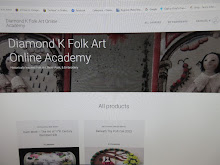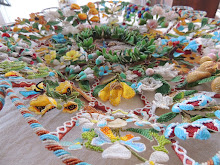
Most people are acquainted with, or at least have heard the term "Marceilles Quilting"- which refers to elegant and superbly hand quilted Boutis (quilts) and Coats (petticoats) from Marseilles, France at the beginning of the 18th century. These were very highly prized, and
subject to much taxation and import restrictions by other countries. These early pieces were entirely hand stitched, using 2 fabric layers, a top and backing, with stuffing in between. Hundreds and hundreds of hours were spent int he making up of a single coverlet or petticoat. This made them extremely expensive, not to mention, it was very hard to keep up with demand, especially as the fashions changed from season to season....
Towards the middle of the 18th century, several London firms began to offer premiums for those entrepreneurs who could find a way to duplicate the elaborate quilting on a loom. NO one thought it could ever be done. Transactions of the Society for Encouragement of the Arts, in 1783, published this 'historical' account:
"When the proposition was first made in the Society, of offering a premium to encourage the making in the loom, an imitation of that Species of Needlework, long known by the name of Marseilles Quilting, it was almost rejected as visionary and impossible; but the laudable spirit of
enterprize, which has always distinguished the Society, determined them to publish the premium, and the consequence has justified the venture. The manufacture is now so thoroughly established and so extensive, being wrought in all the different materials of Linen, Woolen,
Cotton, and Silk, that few persons of any rank, condition, or fix......exist who do not use it in some part of their clothing"
They called this loom woven variety, 'Marseilles Cloth', and some shortened this even more to 'Marcella'. It was woven of double cloth with an extra heavy cording weft between the layers. By the 1780's, merchants in America were ordering this cloth by the yard, and could even choose
from different numbered patterns.

This example is the cotton variety, and is made up into a petticoat held by Colonial Williamsburg. As you can see, from a distance, it is hard to discern if it is hand quilting, or if it has been woven on a loom. This is amazing stuff to me! The 18th c was by no means an era of mechanical
marvels....but it is still mind boggling to me, how anyone could have figured out how to weave this on a loom.
This next example, is a bit of a folding pattern card prepared by Thomas Smith in 1783, of cotton Manchester Goods, that is part of the Winterthur Museum Library.

The coat in the Colonial Williamsburg collection bears striking resemblance to some of these pattern swatches, as does one of my examples here at the LRM.

This particular petticoat has full American provenance, and came to me with its original green brocaded open robe, c1760s. It was most definitely ordered, or brought back to America from England. Examples of Marseilles cloth anything are few and far between, which one may wonder why, if they were so common then, they can scarce be found today? So many common articles of clothing have not survived, as they were worn literally to rags....but in studying my example here, I have come to the conclusion these did not wear time well.

There are several areas of darning on the back, as the silk top threads have worn away leaving the cording to jump out at its leisure. And on the outside, if you look closely, the thin pink silk has worn down on nearly every diamond, showing the cream of the cording beneath.

I cannot imagine these silk ones could be washed with any kind of good outcome. The cotton variety were said to have been very popular for men's waistcoats and summer wear.
 The bottom half of the design, imitates the elaborate quilting with floral bouquets and swags, with the top half's ground done fully in a diamond pattern.
The bottom half of the design, imitates the elaborate quilting with floral bouquets and swags, with the top half's ground done fully in a diamond pattern. If you enlarge this picture, you can make out the tiny pink silk threads that imitate quilting. It is easy to see why these flat goods were so popular~ they were much more affordable that real quilting, and one did not have to wait long for them to be produced. They could be ordered up in the latest fashionable styles, in yard goods, and clothing. One must always take into account, that anything ordered by Americans took 7, 8, or even 9 full months to make its way across the Atlantic on a big Schooner, and once in port, was literally swarmed over like bees on honey!
If you enlarge this picture, you can make out the tiny pink silk threads that imitate quilting. It is easy to see why these flat goods were so popular~ they were much more affordable that real quilting, and one did not have to wait long for them to be produced. They could be ordered up in the latest fashionable styles, in yard goods, and clothing. One must always take into account, that anything ordered by Americans took 7, 8, or even 9 full months to make its way across the Atlantic on a big Schooner, and once in port, was literally swarmed over like bees on honey!





















1 comment:
Wow! Thank you. I have been looking for an explanation of this amazing cloth for quite a while after a collector friend of mine brought a piece in an antique shop.
Post a Comment